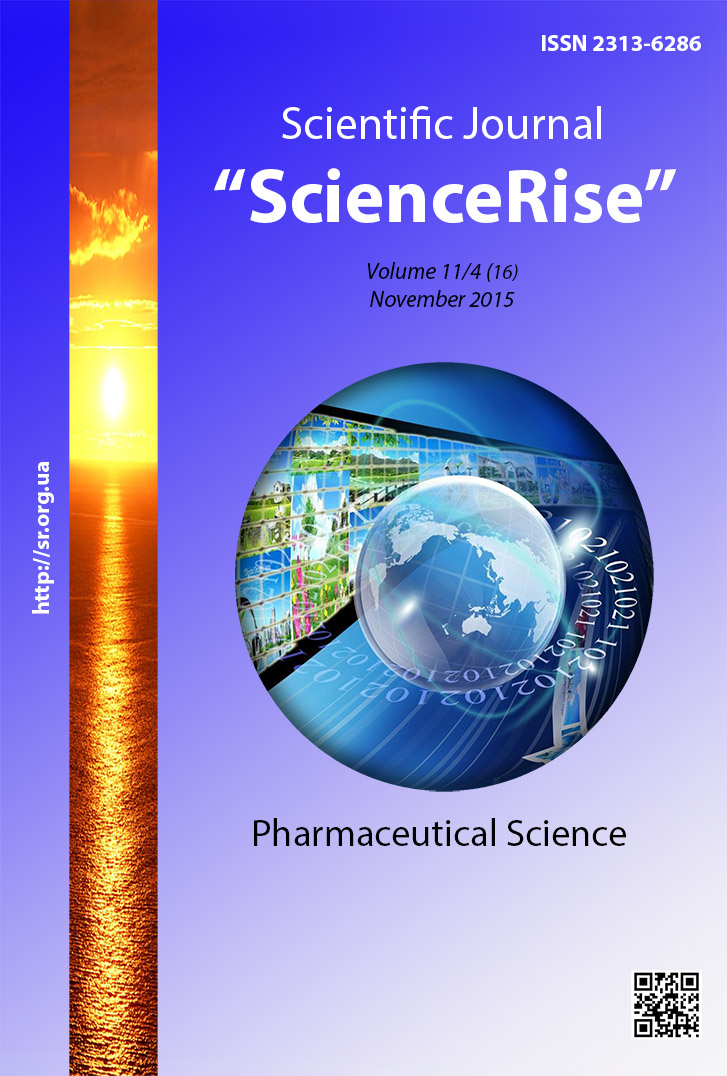Перспективи застосування подорожника великого у медичній та фармацевтичній практиці
DOI :
https://doi.org/10.15587/2313-8416.2015.54487Mots-clés :
подорожник великий Plantago major, фармацевтичний ринок, хімічний склад, фітотерапія, фітопрепаратиRésumé
Розширення напрямків використання добре відомих рослинних об’єктів в медицині та фармації – це актуальне завдання фармацевтичної науки. Сучасна наука розкрила фармакологічні властивості багатьох рослин, проте сьогодні залишається великий обсяг для досліджень в галузі фітотерапії. Однією з відомих лікарських рослин є подорожник великий Plantago major L., який залишається цікавим для вивчення та створення на його основі лікарських препаратів.
Ціль. Метою нашої роботи стало вивчення літературних джерел стосовно біохімічного складу лікарської рослини – подорожник великий та асортименту фітопрепаратів на його основі, які представлені на фармацевтичному ринку України.
Методи. Для вирішення поставленої мети були проведені літературний пошук щодо інформації стосовно Plantago major L., а також структурний, порівняльний та графічний методи аналізу фармацевтичного ринку України.
Результати. В результаті роботи були проведені аналіз літературних даних по відношенню до хімічного складу Plantago major L. та вивчення вітчизняного фармацевтичного ринку стосовно фітопрепаратів у складі яких присутній подорожник великий та інші види рослин роду Plantago L.
Висновки. Лікарська рослина Plantago major L. представляє собою цінність та є перспективною для подальшого її вивчення, а також розробки та створення на її основі нових оригінальних лікарських препаратів
Références
Zhienbaev, T. M., Kurmanova, F. E., Omarova, R. A., Bevz, N. E. (2013). Maslyaniye extracty romashki aptechnoy (Matricaria chamomilla) [Oil extracts of chamomile (Matricaria chamomilla)]. Medicines for people. Modern problems of pharmaceutical therapy and appointment of medicines. Kharkov, 191–196.
Borodina, T. N., Rumsh, L. D., Ckunizhev, S. M. Sukhorukov, G. B. et. al (2007). Vkluchenie extractov lekarsvennyh rasteniy v biodegradiruemyie microcapsuly [Including of extracts of medicinal plants in biodegradable microcapsules]. Biomedical chemistry, 53 (6), 662–671.
Kuznetsova, L. S., Glushko, A. A. (2013). Technologicheskyie issledovaniya atravmaticheskogo ranevogo pokrytiya s sokom podorozhnika I analiz adsorbtsii biologicheski aktivnyh veschestv soka na kollagene [Technological researches of non-traumatic wound covering with plantain juice and analyze of adsorption of biological active substances of juice on collagen]. Modern problems of science and education, 6, 1026.
Nickolaeva, Yu. N. (2011). Krapiva, lopukh, podorozhnik, zveroboy. Lekarstva ot 100 bolezney [Nettle, burdock, plantain, St. John's wort. Medicines for 100 illnesses]. Moscow: RIPOL classic, 110.
Badalyan, Z. V. (2011). Summarnye fitopreparaty podorozhnika bolshogo – vozmozhnosty sovershenstvovaniya tekhnologii [Total herbal medicines of plantain – possibility of improving technology]. Scientific sheets, Series Medicine, Pharmacy, 22 (117), 125–130.
Sosnina, S. A., Oleshko, G. I., Pecherslaya, L. G. et. al (2008). Vidy podorozhnika: soderzhaniye deistvuyuschikh veschestv [Types of plantain: content of active substances]. Pharmacy, 8, 21–24.
Olennikov, D. N., Samuelsen, A. B., Tankhaeva, L. M. (2007). Podorozhnik bolshoy (Plantago major L.). Khimicheskiy sostav i primeneniye [Plantain (Plantago major L.). Chemical composition and application]. Chemistry of herbal raw materials, 2, 37–50.
Olennikov, D. N., Tankhaeva, L. M. (2006). Razrabotka technologii polucheniya extracta podorozhnika bolshogo sukhogo [Development of technology obtaining plantain dry extract]. Chemistry of herbal raw materials, 1, 47–52.
Olennikov, D. N., Tankhaeva, L. M., T. M. Mykhailova, Samuelsen, A. B. (2005). Organicheskie kisloty lekarstvennykh rasteniy Plantago major L. [Organic acids of medicinal plants Plantago major L.]. Chemistry of herbal raw materials, 4, 354–355.
Tamura, Y., Nishibe, S. (2002). Changes in the Concentrations of Bioactive Compounds in Plantain Leaves. Journal of Agricultural and Food Chemistry, 50 (9), 2514–2518. doi: 10.1021/jf011490x
Kortikov, V. N. (2001). Polnaya entsiklopedia lekarstvennykh rasteniy [Full encyclopedia of medicinal plants]. Rostov-na-Donu, 511.
Amr, A. (2007). Merits of anti-cancer plants from the Arabian Gulf region. Cancer Therapy, 5, 55–66.
Kobeasy, I. M., Osama, M. (2011). Biochemical studies on Plantago major L. and Cyamopsis tetragonoloba L. International Journal of Biodiversity and Conservation, 3 (3), 83–91.
Samuelsen, A. B. (2000). The traditional uses, chemical constituents and biological activities of Plantago major L. A review. Journal of Ethnopharmacology, 71 (1-2), 1–21. doi: 10.1016/s0378-8741(00)00212-9
Ovodov, Yu. S. (2009). Sovremenniye predstavleniya o pectinovykh veschestvakh [Modern ideas about pectin substances]. Bioorganic chemistry, 35 (3), 293–310.
Yakovleva, L. V., Marchishin, S. M., Lenytska, O. B., Kozachok, S. S. (2013). Vivchennia antyalergichnoi dii novykh oryginalnikh roslynnykh zboriv [Studying of new original plant species with antiallergenic action]. Phytotherapy. Journal, 2, 37–41.
Olennikov, D. N., Tankhaeva, L. M., Nikolaeva, G. G. (2004). Metodica kolichestvennogo opredeleniya summarnogo soderzhaniya organicheskikh kislot v rastitelnom syrje [Technique of quantitation of total content of organic acids in herbal raw material]. Plant resources, 40, 112–117.
Khortetska, T. V. (2013). Doslidzhennya optymalnykh umov sushinnya listya podorozhnika serednogo [Research of optimal conditions of drying of leaves of plantain]. Zaporozhye medicinal journal, 2 (77), 101–103.
Téléchargements
Publié-e
Numéro
Rubrique
Licence
(c) Tous droits réservés Ірина Вікторівна Герасимова 2015

Cette œuvre est sous licence Creative Commons Attribution 4.0 International.
Our journal abides by the Creative Commons CC BY copyright rights and permissions for open access journals.
Authors, who are published in this journal, agree to the following conditions:
1. The authors reserve the right to authorship of the work and pass the first publication right of this work to the journal under the terms of a Creative Commons CC BY, which allows others to freely distribute the published research with the obligatory reference to the authors of the original work and the first publication of the work in this journal.
2. The authors have the right to conclude separate supplement agreements that relate to non-exclusive work distribution in the form in which it has been published by the journal (for example, to upload the work to the online storage of the journal or publish it as part of a monograph), provided that the reference to the first publication of the work in this journal is included.

